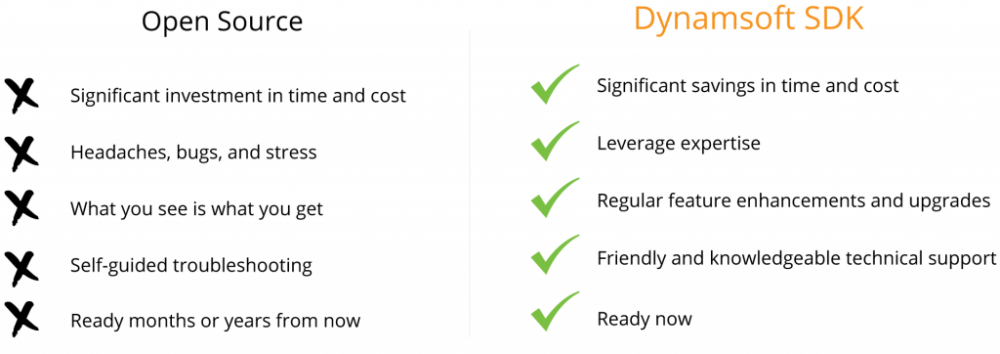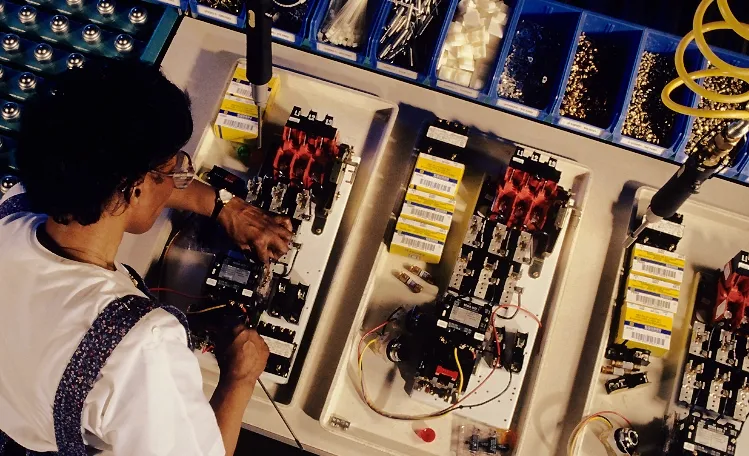11 Facts You Should Know Before Starting a Barcoding Solution

Barcode technologies are used to quickly identify items. As a provider of professional barcode SDKs, Dynamsoft has been involved in computer vision for more than ten years. In this post, we list 11 facts you should know to help you choose a barcoding solution.
We aim to make that selection process easier by highlighting some key considerations. We’ve also put together an ebook that helps software developers and IT managers understand the technologies behind barcoding and the steps necessary for enabling adoption and implementation.
1. Where are Barcodes Used?
Barcodes are used in almost every industry including retail, education, entertainment, financial, government, healthcare, and manufacturing. Here are just some examples:
- Retail stores: self-scanning, mPos checkout, inventory tracking
- Manufacturing businesses: receiving, sorting, stocking, shipping
- Hospitals: patient verification, asset tracking, medication tracking
- Transportation: VIN code reader, driver licenses reader
- Schools: portable devices, library systems, gym equipment, cafeterias
We have posted an article about some benefits achieved using barcodes in business. Read about the managers’ experiences and how they were able to help their customers.
2. How do Barcodes Work?
A barcode encodes information into black and white bars and elements that can be read by a barcode scanner. Once a barcode is identified, the barcode API decodes it into binary digits like 10110010. After that, the system converts the binary digits into human-readable data according to standardized specifications, such as numbers, letters, and special characters. Data can be retrieved from a database and can show information such as price, origin, production date, and weight of each product.
3. Choosing the Right Barcode Types
There is a lot to consider when choosing the right barcode to use. You should familiarize yourself with the various barcode types, their capabilities, and their requirements to ensure a proper barcode selection for your given scenario.
UPC-A, UPC-E, and EAN-13 barcodes are generally found on packaging for consumer goods. This includes items on the shelves of your local supermarket, as well as books, magazines, and newspapers. QR codes appear on the packaging to encode a link to a company website or online instructions for a product’s use.
Dynamsoft Barcode Reader supports all major 1D and 2D barcodes, and we are expanding the list constantly. You can review our Comprehensive Barcode Guide to learn more about which barcode types we support.
We also list some sets of comparisons of commonly confused barcodes:
- UPC vs. EAN
- Code 39 vs. Code 128
- QR Code vs. PDF417 vs. DataMatrix Code
- Intelligent Mail barcode vs. Postnet vs. Planet
If you’d like to compare other barcode types, check out our online barcode comparison tool.
4. Choosing the Right Barcode Scanner
Once you have decided which barcode type you are going to use, the next step is to choose the right scanner. There are two common barcode scanners: laser-based barcode scanners and 2D imagers.
Laser-based Barcode Scanners
Laser-based barcode scanners were invented to read linear barcodes and are simple and low-cost barcoding solutions for many industries, while still being reliable.
2D Imagers
With 2D barcodes becoming more prevalent, the market for 2D imaging scanners continues to grow. 2D imaging scanners use a camera and image processing techniques to decode barcodes. In the barcode world, smartphones can be classified as 2D imagers. They are now widely used as barcode readers, in particular for QR codes.
Depending on your needs, you will want to consider which hardware scanners work best for your application because each comes with its pros and cons.
5. Scanning Capabilities
At the heart of any barcode reader is the ability to efficiently scan barcodes, but not every barcode will be perfect. Consider whether your barcodes will be on shiny or reflective surfaces, will the barcode be distorted from condensation, will it be flat or curved, and at what orientation and angle will it be?
Barcode readers should be capable of reading perfect barcodes that are flat and have clear black and white edges. However, how will they perform with barcodes that are damaged or distorted?
There is a variety of commonly occurring damaged barcode scenarios that could be encountered. For example:
- Improper lighting
- Screen glow and reflection
- Blurriness
- Poor contrast
- Damage and distortion
Be sure to test your barcode reader SDK under these sub-optimal conditions. A good barcode reader app should be able to scan despite obstacles.

Try our free online demo to test how Dynamsoft Barcode Reader works with your specific barcodes.
6. Improve Barcode Recognition
Recognition Speed
Barcode reading speed and accuracy are desirable for maximizing efficiency and enhancing customer experiences. Retailers and warehouse managers need a barcode scanner that works quickly and accurately every time, and customers don’t want to be held up any longer than necessary.
To maximize performance, learn about how to improve barcode recognition speed with:
- Location
- Quiet zone
- Direction
- Rotation
- Smooth-zooming
- Multi-threading
Recognition Rates
What is the difference between recognition speed and recognition rate, you ask? Great question! Recognition speed has to do with how fast a barcode scanner is able to scan a barcode. Recognition rate is the number of barcodes recognized compared to the number of barcodes on the images.
Learn more about how to improve barcode recognition rates with image pre-processing.
7. Barcoding Solution with Different Development Environments
Whether someone is scanning with an iOS or Android device, and whether they have the latest operating system (OS) or an older version, platform support should be exhaustive to avoid alienating customers.
The solution should be easy to integrate into your application. Dynamsoft Barcode Reader offers C, C++, .NET, and JavaScript, and 32-bit or 64-bit environments on Windows, Linux, macOS, iOS, and Android. It also supports commonly used programming languages including C#, VB.NET, Java, C++, Python, JavaScript, etc.
Determine all the possible barcodes your end-users will scan, and test each of them. This might include considering any industry and related regulation needs and requirements.
8. Integration to an Existing Web or Mobile Application
As modern technology developed along with a wide adoption of mobile devices, a new two-dimensional imaging scanner emerged. A webcam or a mobile phone with a camera can be easily converted to a barcode scanner. This allows for easy integration to an existing web or mobile application.
To learn more about implementing a barcode reader into a browser application with JavaScript, check out this tutorial video:
9. What about Open Source?
While it may be tempting to go with an open source barcode SDK, they have many hidden drawbacks. Although the initial cost appears to be cheaper, you have to factor in all the labor involved with problem-solving and configuring, de-bugging, figuring out compatibility issues, ongoing maintenance, and so on. In the long run, open source barcode SDKs tend to be much more costly and less effective. An analogy would be like running a business and handling all the accounting on your own, if that isn’t your specialty. It’s possible to do, but not advised. Instead, it’s better to trust an expert in that area.
It has taken us years to perfect our SDKs and our work is still ongoing. We’ve invested heavily in research and development – tweaking and debugging so that you can leverage our SDKs into your desktop, web, and mobile applications. This can save you months, or years, of development time and cost so you can get your application up and running today.

With just a few lines of code, Dynamsoft Barcode Reader SDK integrates into your solution today. Utilizing our experience and expertise will drastically reduce your development time and headaches. Plus, we offer technical support, security, updated versions, etc., which is not something you get with open source solutions.
Reading opinions in online forums, you will find that, most of the time, open source barcode SDKs only resulted in a waste of time. As one user put it:
“We are using a free library called ZXing but it has not performed as we would like. We have about 30 apps that we have built that we use internally and they all use this free lib and is manageable but not good enough for external apps.”
10. Customer Service
An often overlooked consideration is the need for prompt and reliable technical support. It’s all too common nowadays to send people to hunt through a knowledge base first, then sending an inquiry email but only getting a response days or weeks later. Dynamsoft offers immediate technical support options, such as Chat or phone support at 1-877-605-5491.
11. More Than a Barcode Reader SDK
Flexibility and Versatility
To help customers achieve the best barcode readability, a good barcoding solution should offer a framework based on flexible scan settings. We touched on the importance of being able to customize the area on a page where a barcode reader should scan. In addition to zonal scan capabilities, a good SDK will also let developers set page numbers to scan. This includes allowing a single barcode scan per page or multi-code scans across single or multiple pages.
User Experience
Another often overlooked consideration when choosing a barcode reader SDK is how users will interact with the device. Some may point their cameras at an angle, which will skew the barcode, or the scan distance will vary. A reliable barcode SDK should be able to adapt and handle most of these scenarios.
A barcode scan is accomplished by using a video stream, so a good SDK algorithm will automatically select the best frame from many frames captured in a video stream. Or the SDK should have the flexibility to let app designers identify which frame to use, such as returning the one in the center, or returning the code with the highest confidence level.
Taking the Next Step
Ready to take the next step and see why many of the world’s best companies trust Dynamsoft? Please check out our Online Demo, sign up for a Free 30-day Trial, or speak to one of our Technical Support Members.



 Blog
Blog

